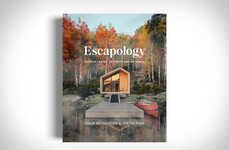
The Queer Spaces Book Collects 90 LGBT+ Spaces Around the World
Kalin Ned — May 19, 2022 — Art & Design
References: bookdepository & dezeen
The recently released Queer Spaces book acts as a helpful atlas for different LGBT+ spaces around the world. The publication was debuted by RIBA Publishing and its official title is 'Queer Spaces: An Atlas of LGBTQIA+ Places and Stories.' The idea behind a publication such as this is to democratize architecture, empower individuals, and promote safer spaces within the industry. The 90 places featured in the book were carefully selected by 50 global contributors. According to historian Joshua Mardell and designer Adam Nathaniel Furman—who were driving forces for this publication—the Queer Spaces book presents "an accessible new history for an area of architecture that has been ridiculed, othered and dismissed for too long" and it fulfills the need for a powerful resource for anyone queer or non-normative.
Image Credit: Dezeen
Image Credit: Dezeen
Trend Themes
1. Queer Space Mapping - There is an opportunity to develop digital platforms for queer spaces mapping, making it possible for LGBT+ travellers to easily find these spaces.
2. Queer-inclusive Architecture - Architects and designers can embrace queer culture and architecture, by incorporating queer inclusiveness and diversity into the built environment.
3. Queer Cultural Heritage Preservation - There is an opportunity to protect, document, and preserve queer cultural heritage by including queer activism, identity politics and liberation architecture in the mainstream conservation policy and practice.
Industry Implications
1. Travel and Tourism - Tourism operators can leverage Queer space mapping to develop travel packages, promoting LGBT+ friendly spaces and ensuring inclusive experiences for gay tourists.
2. Architecture and Design - Architects and designers can promote Queer-inclusive Architecture practices, ensuring that LGBT+ people are welcome and feel safe in designed spaces.
3. Cultural Heritage and Conservation - Queer cultural heritage preservation should be included in conservation policy and practice to promote an inclusive view of history and to make everyone feel welcome and heard.
1.3
Score
Popularity
Activity
Freshness























